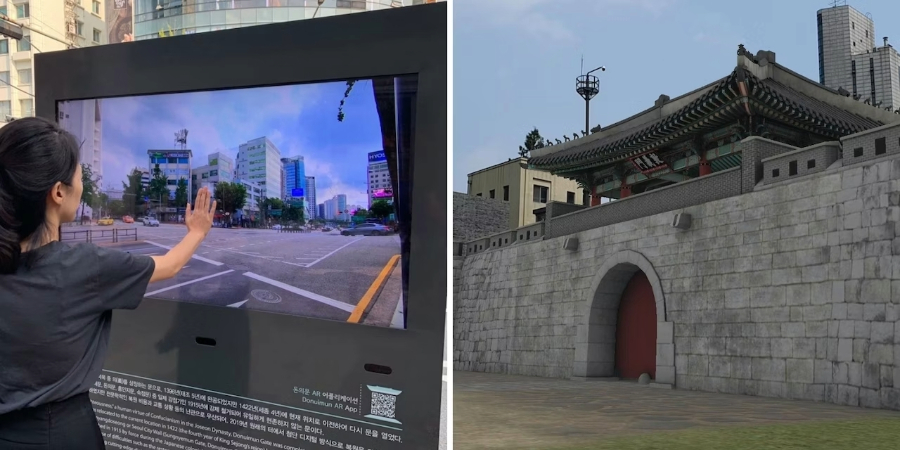Exploring Cultural Heritage Through Augmented Reality (Realm)
Cultural heritage sites and artifacts hold a wealth of history and significance, but often, accessing and understanding them can be challenging. However, with the advent of augmented reality (AR) technology, a new and exciting way to visualize and interact with heritage sites and artifacts has emerged. In this blog post, we will delve into the world of heritage visualization in AR and explore how this innovative technology is transforming the way we experience and learn about our cultural heritage.
REALM is an innovative project that utilizes Augmented Reality (AR) technology to provide users with immersive experiences of monuments and cultural heritage sites. Through the dedicated AR app, users can select specific locations to explore in detail, gaining valuable insights into the historical and cultural significance of each site. This application aims to enhance the way people engage with and learn about monuments, fostering a deeper connection to our rich cultural heritage.
In the AR component of the REALM project, users leverage augmented reality technology to overlay digital information onto the real world environment, enhancing their perception of monuments and cultural heritage sites. By utilizing the camera on their devices, such as smartphones or tablets, the app seamlessly integrates virtual elements with the physical surroundings.
As users choose a particular monument or cultural site within the app, AR functionalities come into play. The technology superimposes historical information, 3D models, and interactive content onto the live camera feed, allowing users to see detailed representations and learn about the significance of each architectural marvel.
This immersive AR experience transforms the way individuals engage with cultural heritage, offering a dynamic and educational platform that goes beyond traditional methods of learning. Users can explore intricate details, historical context, and architectural features by simply pointing their devices at the chosen monument, making the learning experience both engaging and accessible.
Heritage Visualization in AR
Augmented reality technology allows for the digital overlay of historical or cultural heritage sites onto the real world, creating an immersive and interactive experience for users. By using AR apps or devices, users can explore heritage sites in a whole new way, gaining deeper insights into their history and significance.
For instance, imagine standing in front of a centuries-old castle, and through your AR-enabled device, you can see a virtual reconstruction of the castle as it appeared in its original state. You can walk around it, examine intricate details, and even witness historical events unfold through AR-enhanced storytelling.
Moreover, AR can breathe life into historical artifacts by creating 3D models that users can interact with virtually. This means that a museum visitor can hold up their smartphone or tablet and see a virtual representation of an ancient artifact, rotating it, zooming in for a closer look, and accessing additional information about its origin and significance.
Preservation and Education
Heritage visualization in AR not only provides an engaging experience for users but also plays a crucial role in the preservation and promotion of cultural heritage. By digitally reconstructing historical sites and artifacts, AR technology can help to preserve them for future generations, especially in cases where physical preservation may be challenging or costly.
Furthermore, AR can be a powerful educational tool, offering immersive learning experiences for students and enthusiasts alike. It can bring history to life, making it more accessible and captivating, thereby fostering a deeper understanding and appreciation for cultural heritage.
Tourism and Conservation
From a tourism perspective, heritage visualization in AR can enhance the visitor experience by offering interactive and informative tours of heritage sites. Visitors can use AR to gain a deeper understanding of the historical context, architecture, and cultural significance of the sites they are exploring, enriching their overall experience.
Additionally, AR can be utilized in conservation efforts by creating digital archives of heritage sites and artifacts, aiding in their preservation and documentation. This technology can also be used to raise awareness about the importance of preserving cultural heritage, and fostering a sense of responsibility and stewardship among communities and organizations.
Applications of AR in Cultural Heritage
Over the last decade, AR has been applied in various ways to enhance cultural heritage:
- 3D Reconstruction: Creating digital models of cultural artifacts and historical buildings.
- Digital Heritage: Preserving intangible cultural elements through digital means.
- Virtual Museums: Offering immersive experiences beyond traditional exhibits.
- User Experience: Enhancing visitor engagement and learning.
- Education: Using AR for educational purposes related to heritage.
- Tourism: Enriching tourists’ experiences at heritage sites.
- Intangible Cultural Heritage: Capturing oral traditions, rituals, and folklore.
- Gamification: Turning heritage exploration into interactive games.
Conclusion
Augmented reality is revolutionizing the way we engage with our cultural heritage, offering a dynamic and interactive approach to heritage visualization. By leveraging AR technology, we can explore historical sites, interact with ancient artifacts, and gain a deeper appreciation for the rich tapestry of our collective history. As AR continues to evolve, its potential to preserve, educate, and promote cultural heritage is boundless, ensuring that the legacy of our ancestors remains vibrant and accessible for generations to come.
Source
- https://www.inglobetechnologies.com/augmented-reality-cultural-heritage/
- https://www.mdpi.com/2076-3417/12/19/9859

